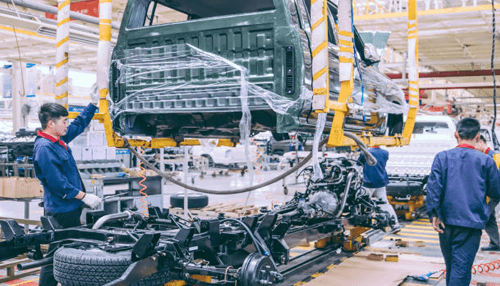Just as the automotive industry was regaining traction after the devastating blow from Covid in recent years, news of the new Omicron variant and its intense spread has experts worrying about another industry disruption, leading to higher costs and lower production once again.
From factory shutdowns to semiconductor shortages, several factors were at play during the pandemic, limiting production and not being able to keep up with market demand. Even popular offerings like the Ford Explorer and Toyota Corolla were in short supply, despite high demand. While a lot of this can be traced back to Covid, most of the issues still being faced today are because of semiconductors, or rather the lack of them.
Because modern cars are run by a range of computers and electronics, dependence on semiconductors has significantly increased in recent years, adding to the supply and production issues. Chip shortage has also affected the development of new technologies and driver assistance features, most notably in the semi-autonomous and autonomous vehicle sectors. Many manufacturers in the automotive industry have figured out a way around this by cutting down features that rely on semiconductors and giving their vehicles at a discount. With the shortage still not sorted out, the Omicron outbreak has the potential to worsen the situation just as it was bouncing back to normal.
When the pandemic started back in early 2020, it led to a worldwide shutdown of assembly lines and factories, closed dealerships, lower car sales, and traveling in general. Even in major cities, just 30% of the usual traffic remained on the streets, and the net result is a decline in automotive industry sales by over 40% within the first month since lockdown started.
However, as the world grew accustomed to this new normal and the population opened up once again, everyone suddenly started preferring personal transport over buses and trains, to avoid the virus and isolate themselves from others. This eventually led to an unprecedented rise in demand for new models, catching the automotive industry by surprise. Because of the manpower and semiconductor shortage, the automotive industry was not capable enough to meet the rising demand, resulting in inflated used car prices and the unavailability of even the best-selling models.
More than a year since then, the market has finally started to bounce back to its former self and has more or less adapted to the Covid-19 restrictions. However, shortage issues are still prevalent across the automotive industry, leading to production constraints.
As the lockdown was lifted and factories started reopening, several new protocols were implemented to restrict virus spread and several workers continued to work from home.
However, the new Omicron variant looms over the world, setting the stage for another lockdown after spreading to over 25 countries. Fortunately, the experience gained from the last two years of battling Covid will certainly help this time around to avoid a similar situation and recover quickly.
Stocking up on inventory and components
First and foremost, the most important step to avoid a slowdown is to stock up in all the required components for the foreseeable future to avoid production delays. Instead of the just-in-time manufacturing process that only stocks upon components as required without any warehousing, manufacturers should stock up on all the required components for an additional 1 or 2 months to handle sudden supply restrictions or lockdowns. When the initial outbreak started, it took around a month for the spread to reach a point where lockdown was the only answer. We can predict the same for the new Omicron variant and take preventive measures to avoid limited production.
Where the inventory is located is another concern. Instead of storing all of it in one location, spreading it out will be more effective and reliable, since access can be cut off abruptly depending on where the virus spreads, leading to localized lockdowns.
From recent experience, it is clear that countries that export semiconductors like China, Taiwan, and Hong Kong will stop exports whenever a new variant is detected, and so far, Omicron seems to be the fastest-spreading variant detected. So, always staying ahead of the game and stocking up on components to keep production going for another 1 or 2 months is recommended, especially the ones that are imported.
Workforce disruptions
If and when lockdowns are implemented, the lack of a workforce at factories is another major concern. To avoid spreading the virus, factories should implement strong rules and regulations along with provisions for keeping their employees onsite. Their families should also be considered in this case. By keeping their workforce onsite, manufacturers will be able to keep their facilities running at optimum capacity. Healthcare facilities should also be implemented to avoid any complications and keep the workforce healthy.
Modified manufacturing methods to cope with sudden shortages
Along with stocking up all the required materials for one or two months, manufacturers should also focus on flexibility with their manufacturing processes, providing alternative methods when required. To cope with the ongoing chip shortages, several manufacturers have already cut down on the available features, providing a more basic infotainment system, connectivity, and more, cutting down the use of valuable semiconductors per vehicle to keep production at optimum capacity. This also means research and development will take a significant hit, limiting new emerging technologies available on the latest cars.
This will help preserve semiconductors and other components for use in the most crucial parts like engine management, body control modules, and safety systems. Some manufacturers have even gone as far as excluding a touchscreen display, not including a spare wheel, and even selling models without a factory-fitted infotainment system, all for the sake of preserving chips. While this will lead to discounts for the end consumer, these models can be considered inferior to their original counterparts. But, this is the most effective way to keep production flow at its peak.
Flexible manufacturing processes should also be implemented, using alternative components to keep the flow going without compromising quality. This will also lead to adapted production layouts to cope with the new flexible manufacturing processes.
As of today, several auto manufacturers are evaluating the situation and the effects of the Omnicron variant on the production process.




